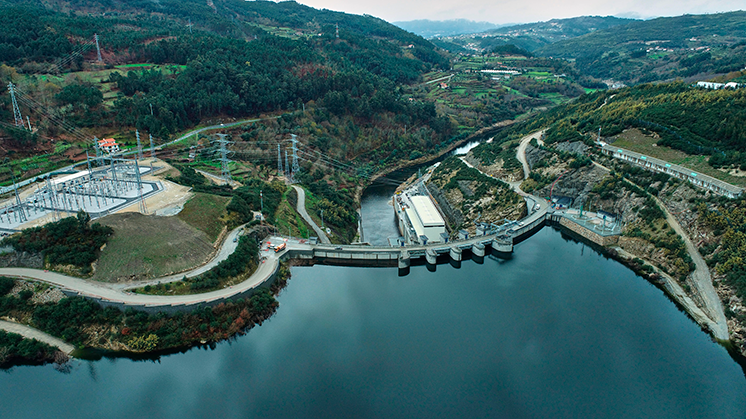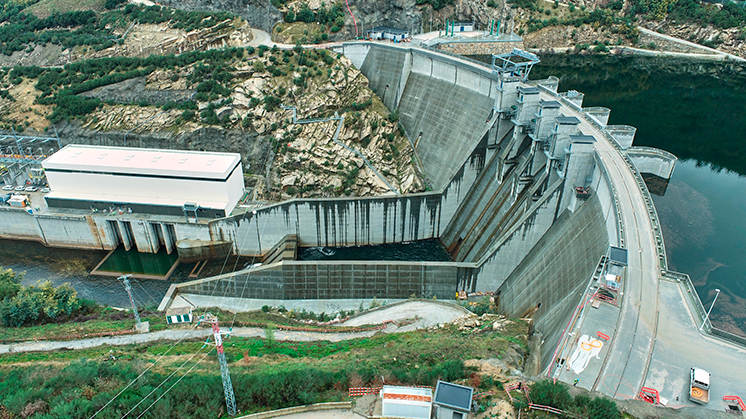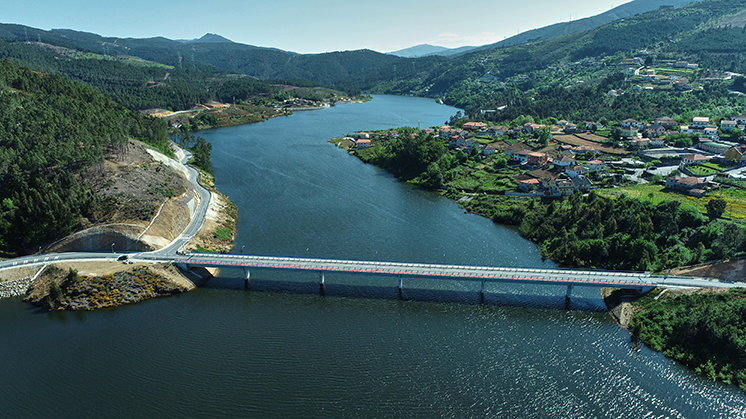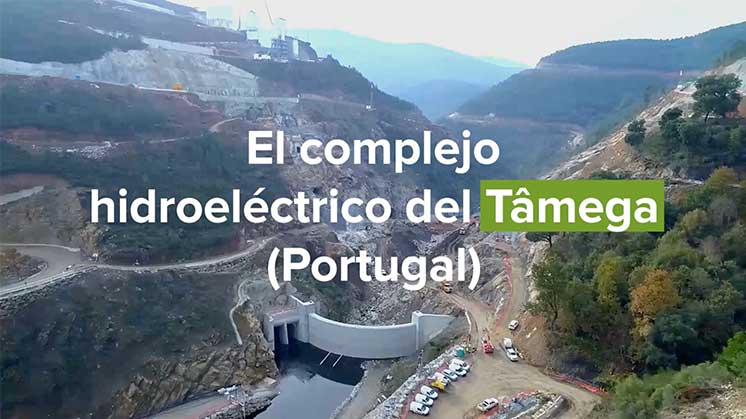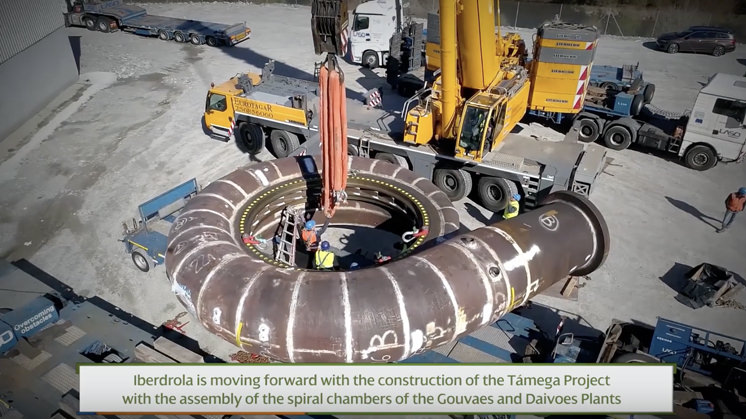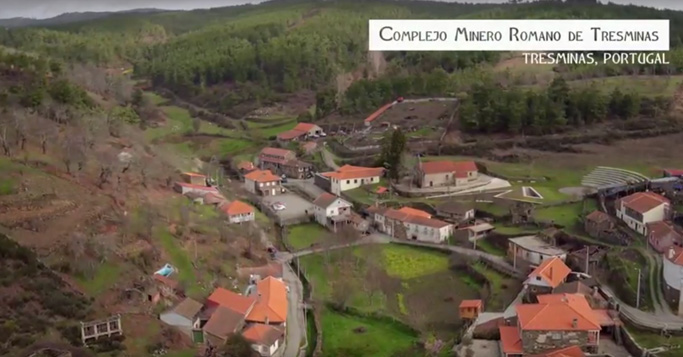Tâmega giga battery
Tâmega: one of the largest hydroelectric projects developed in Europe in the last 25 years
Hydroelectric power Energy storage Portugal Operating plants
The Tâmega hydroelectric complex in northern Portugal is one of the largest energy initiatives in the country's history and one of the largest energy storage facilities in Europe. This system includes three dams with a combined capacity of 1,158 MW and two wind farms that will reach 274 MW. The construction of Tâmega has marked a milestone in the transition to a cleaner and more efficient energy model.
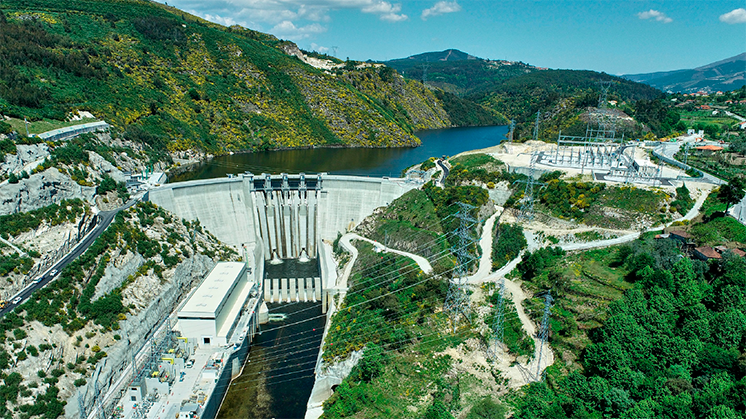
Tâmega river giga battery




The hydroelectric Tâmega project External link, opens in new window. iconsists of three power plants: Gouvães, Daivões and Alto Tâmega, located over the Tâmega River, a tributary of the Duero in the north of Portugal, close to Oporto. The three plants have a total installed capacity of 1,158 MW, which represents an increase of 6% of the country's total installed electricity capacity in 2024.
External link, opens in new window. iconsists of three power plants: Gouvães, Daivões and Alto Tâmega, located over the Tâmega River, a tributary of the Duero in the north of Portugal, close to Oporto. The three plants have a total installed capacity of 1,158 MW, which represents an increase of 6% of the country's total installed electricity capacity in 2024.
The complex is capable of producing 1,766 GWh per year, enough to meet the energy needs of the neighbouring towns and the cities of Braga and Guimarães (440,000 homes). Furthermore, this large renewable infrastructure has a storage capacity of 40 million kWh, equivalent to the energy consumed by 11 million people during 24 hours in their homes.
Tâmega makes it possible to diversify production sources, avoiding the import of more than 160,000 tonnes of oil per year and the emission of 1.2 million tonnes of CO2 per year. It will also promote to the economic activity and the employment in the region, since it is estimated that during the entire construction phase 3,500 direct jobs and 10,000 indirect jobs have been generated — 20 % of them from neighbouring towns —through more than 100 providers— 75 of them from Portugal. Several hundred people will be hired in operational phase.
The project, which has involved an investment of more than 1.5 billion euros, including funding from the European Investment Bank (EIB). In July 2018, this financial institution loaned Iberdrola 500 million euros, the first tranche of the 650 approved in total for the funding of this development.
The project also includes, in its Environmental Impact Statement (EIS), a number of ecological system compensation measures, such as the reforestation of over 1,000 hectares, the planting of 17,000 cork oaks, and actions to improve the populations of protected fauna found in the area.
As for their entry into operation, Gouvães and Daivões started operations in early 2022 and Alto Tâmega has been operational since the end of 2024.
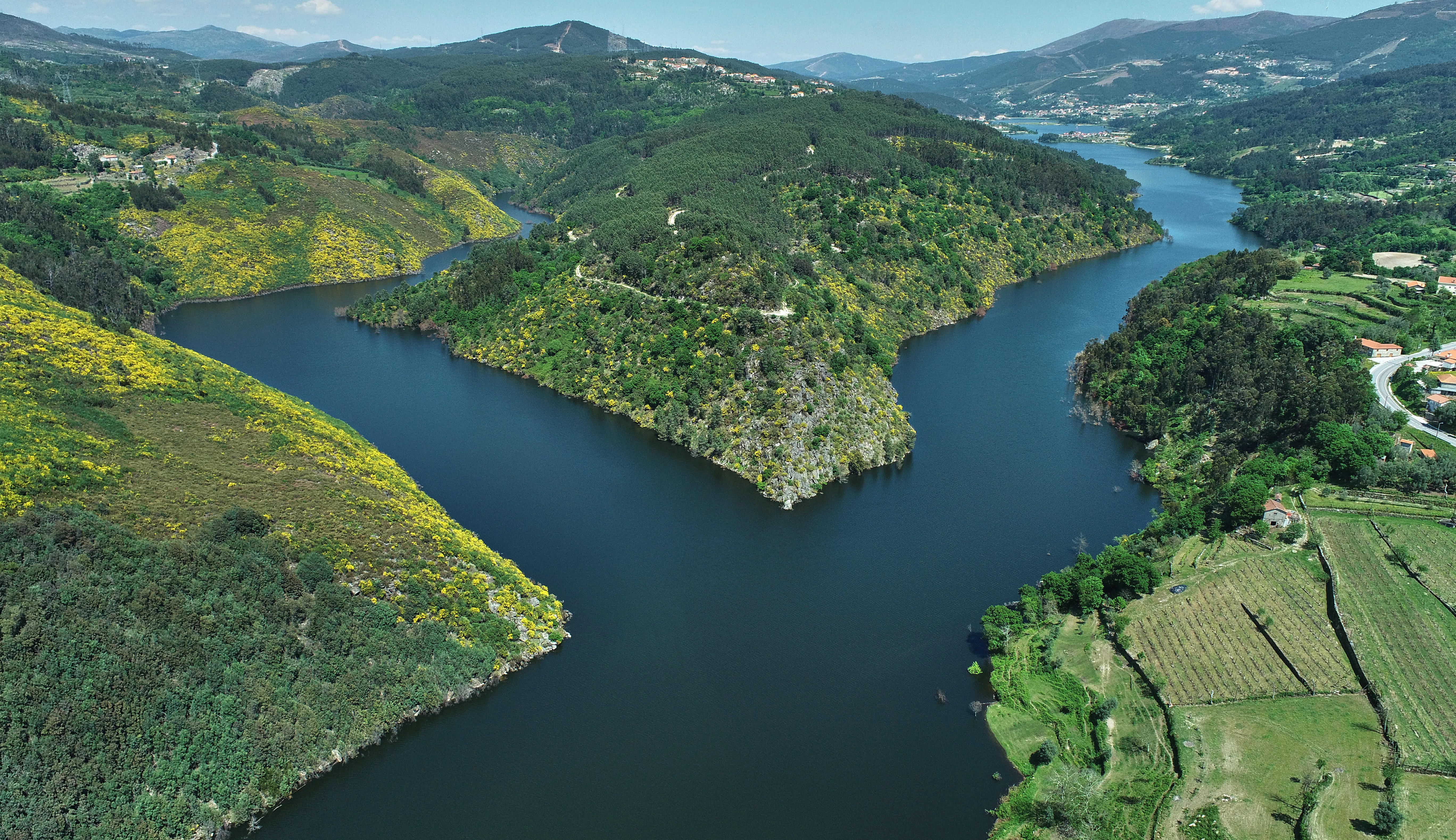
Construction of the Tâmega Hydroelectric Complex
Tâmega: the most innovative hydroelectric complex in Europe.
The Gouvães pumping hydroelectric plant will store enough energy to supply two million Portuguese for 24 hours.
The Tâmega project reaches its final phase with the filling of the reservoirs, which will facilitate the start of the turbination and pumping tests.
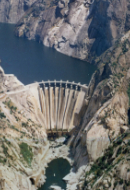
What is hydroelectric energy
Find out how hydroelectric power plants work.

Types of dams
There are different types of dams depending on their materials or mechanisms.

Hydropower terms
The 10 most relevant concepts in hydropower.
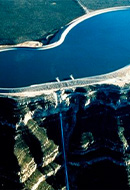
Pumped-storage hydropower plants
Do you know what pumped-storage hydropower stations are used for?
A hybrid plant
The hydroelectric power plants will be joined by two wind farms, which will turn the complex into a hybrid generation plant. In 2024 we obtained the final environmental authorisation to build what will become one of the largest wind farms in Portugal with a capacity of 274 MW.
These are the first grid-connected plants of this type to be built in the area surrounding the three power plants (Gouvães, Daivões and Alto Tâmega) that make up the Tâmega complex.
Generating electricity from two sources will improve the efficiency of the electricity system: wind power production provides energy to consumers during peak periods, while the pumping system will be fed when there is no demand on the grid.
The company will be able to manage supply and demand between hydro and wind depending on the availability of both resources, but also on the dynamics of electricity market prices.
Tâmega giga battery


- Hydroelectric development at Upper Tâmega
- Dam height: 104.5 m
- Hydraulic circuit length: 50 m
- Gross fall: 87 m
- Installed capacity: 160 MW
- Reservoir area: 468 ha
- Reservoir volume: 132 hm³
- Hydroelectric development at Daivões
- Dam height: 77.5 m
- Hydraulic circuit length: 250 m
- Gross fall: 64.5 m
- Installed capacity: 118 MW
- Reservoir area: 340 ha
- Reservoir volume: 56.2 hm³
- Hydroelectric development at Gouvães
- Dam height: 34 m
- Hydraulic circuit length: 7.640 m
- Gross fall: 657 m
- Installed capacity: 880 MW
- Reservoir area: 176 ha
- Reservoir volume: 13.7 hm³

Pumping system
- The only technology that stores large amounts of energy efficiently.
- Essential as a back-up and support for other renewable energies, especially wind and photovoltaic.
- It contributes to the stability of the electricity system thanks to its enormous flexibility to respond to demand changes.
- It moderates electricity prices by producing stored energy at times when the system needs it most.
- Independent operation of the hydraulics.
 VER INFOGRAPHIC: Tâmega giga battery [PDF]
VER INFOGRAPHIC: Tâmega giga battery [PDF]
Progress of the construction works
The creation of the Daivões reservoir involved the construction of a bridge about 200 m long and 35 m high, more than 5 km of power lines, more than 7 km of roads, as well as two wastewater treatment plants.
This Daivões reservoir is the lower reservoir of the 880 MW Gouvães pumped-storage hydroelectric power plant. In January 2022 Iberdrola commissioned the hydroelectric power plant's first power unit - a 220 MW capacity turbine - starting to deliver clean electricity to the grid from the Tâmega gigabattery.
This plant is reversible, i.e., it allows water from the Daivões reservoir to be stored in the Gouvães reservoir, taking advantage of the more than 650 metres difference in elevation between the two. In this way, energy can be pumped out when there is excess production and recovered when necessary. Its storage capacity allows for the continuous supply of electricity to the metropolitan area of Porto for 24 hours.
In March 2021, the first filling of the Daivões reservoir was concluded. Its associated power station will have a capacity of 118 MW thanks to the installation of three generator sets. This was the culmination of the design and construction of a concrete gravity arch dam with a height of 77.5 m and a crest length of 265 m, using 240,000 m³ of concrete.
This Daivões dam is the lower reservoir of the 880 MW Gouvães Hydro-Electric Pumped Power Station. In January 2022, Iberdrola has synchronised the first 220-MW turbine at the hydroelectric power plant, delivering clean power to the grid for the first time.
The Gouvães has produced aggregates for exclusive use in concrete mixes for the Tâmega hydro-electric complex; including those required to build the dams. This quarry is forecast to produce over 2 million tonnes of aggregates, equivalent to the weight of 5,000 fully equipped Boeing 747s carrying passengers.
Learn more about the Tâmega hydroelectric complex.
Progress of the works of Tâmega project.

"We will continue to drive the energy transition in this country and, with it, the creation of wealth and well-being for all Portuguese people"
Ignacio Galán, executive chairman of Iberdrola Group
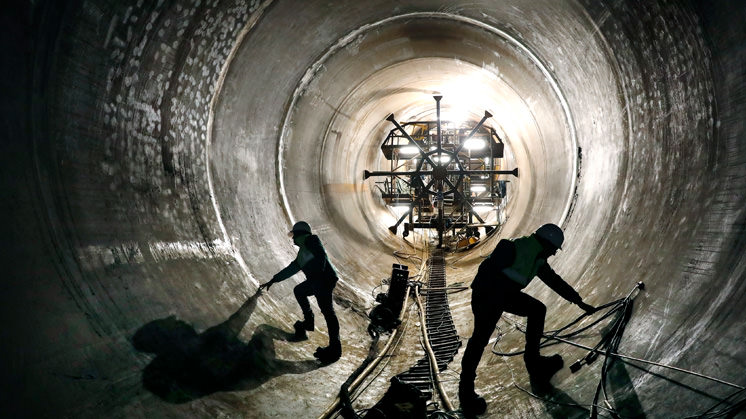

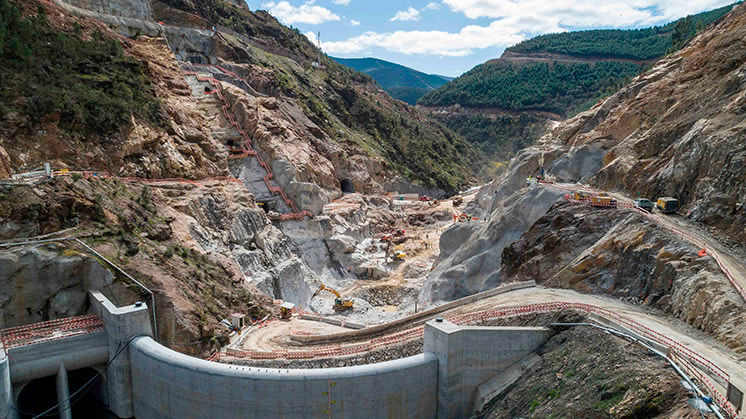
Pumping technology, the most efficient storage
The Tâmega giga battery will provide almost 900 MW of pumping capacity to the Portuguese electricity system, which is an increase of more than 30 % compared to the megawatt capacity available to the country today.
Iberdrola is leader in energy storage with an installed power of 4,000 MW using pumping technology, the current most efficient storage method, since it generates no atmospheric contaminating emissions and its performance is much higher than that of the best storage banks in the market. The company expects to reach 90 million kilowatt hours (kWh) of storage capacity by 2022, which is an increase over 2018 of almost 30 %: 20 million kWh more, equivalent to 400,000 electric car batteries or 1.4 million batteries for residential use.
Hydroelectric power plants like the Tâmega are a safeguard for the electrical system. The largest facility of this kind in Europe is the Cortes-La Muela complex in Valencia.
Sociocultural and environmental action plan
-
This Plan, developed in the context of the Tâmega project and signed with the different Municipal Chambers involved, includes a record amount of more than €50 million for the economic, social and cultural development of the Upper Tâmega region.
The purpose of the program is to contribute to the development of the region and improve the standard of living of the population — it's estimated that 3,500 direct and 10,000 indirect jobs will be generated during the execution of the complex — as well as to preserve the environment where the project will be carried out, from an environmental point of view. Planned actions will be carried out in the municipalities of Ribeira de Pena, Vila Pouca de Aguiar, Cabeceiras de Basto, Boticas, Chaves, Valpaços and Montalegre.
An example is the region of Boticas, in which Iberdrola has participated in the development of the Boticas, Nature and Biodiversity park, building accommodation for visitors and encouraging actions for the compensation of the natural environment's flora and fauna.
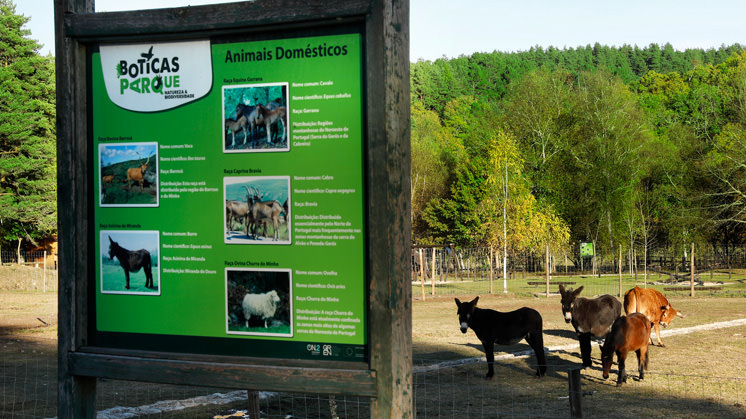 Boticas, Nature and Biodiversity park.
Boticas, Nature and Biodiversity park.The company is going to carry out this type of remedial action for the local flora and fauna both in Boticas and in Cabeceiras de Basto, Ribeira de Pena, Vila Pouca de Aguiar and Chaves by signing two collaboration protocols. The actions planned include the management, recovery and conservation of forest populations of indigenous species, the recovery of riverside forests and improving the connectivity between river courses, planting cork oaks and improving aquatic ecosystems.
In addition to these projects, Iberdrola is funding other activities, such as the improvement of the public sewer and water supply networks, upgrading and optimising sporting facilities, upgrading the equipment used by fire brigades, new recreational areas, etc. In addition, it has co-funded the construction of the new and flagship facilities and installations in the area, such as the Alvão Village Campsite, the Pedras Salgadas Horse Riding Centre or the Educational Health Resort in Vidago.
With this type of aid, Iberdrola consolidates its commitment to sustainability and social responsibility.
-
Tresminas Roman gold Mining Site
Tresminas Mine Complex, Portugal. Video voice transcription (Spanish version) [PDF] External link, opens in new window.
As part of the construction of the large Tâmega Hydroelectric Complex, Iberdrola has also promoted a visit to the Tresminas Roman gold Mining Site, a project that is part of the compensation actions carried out by the company pursuant to what is established in the Environmental Impact Statement.
With the investment of 1.84 million Euros in the Tresminas Mine Complex, Iberdrola is demonstrating its commitment to the economic, social, cultural and environmental development of the communities where it operates. The company is collaborating with the Vila Pouca de Aguiar Town Council and the North Portugal Regional Department of Culture in the historical, archaeological and heritage enhancement of the region. This investment started in 2016 and is expected to continue until 2023.
The company has allocated, between 2016 and the end of 2018, around 850,000 Euros which, throughout this year, will be invested as follows:
- The funding of the technical equipment.
- The continuation of the historical geological and fauna and flora studies in Tresminas.
- The acquisition of equipment for visits to inverted cone pits and mine-shafts, and for their maintenance and/or clearance.
- The construction of the support building and structures and equipment to support movement in the inverted cone pits and mine-shafts.
Tresminas, one of the largest aurifer explorations
The Tresminas Roman Mine Complex was, during the Roman Era, one of the main gold explorations in the primary deposits of the conventus bracaraugustanus and one of the most significant ones in the Northwest of the Peninsula: it is estimated that between the I and III centuries A.D. around 25 tonnes of pure gold were obtained from Tresminas, which involved the ejection of millions of tonnes of rock excavating open inverted cone pit mines.
Iberdrola is committed with this initiative to the preservation of local and national heritage in the region of Tresminas, as well as to make the archaeological and historical importance of this mine complex well known and to boost tourism in the area.
The investment made by the company allows a set of actions to be carried out that benefit the Tresminas Mine Complex, facilitating its future recognition as an Archaeological Park, which will safeguard the materials associated with Roman mining and the landscaping of the area.
Tresminas is part of the municipality of Vila Pouca de Aguiar's strategic pillars in terms of cultural tourism. The efforts made over the last few months, both at local and regional level, following the enhancement of the heritage and tourism value of Tresminas, have already resulted in an increase in the number of visitors to the region.
Alto Tâmega, candidate to be a world heritage site
In fact, these results have been supported by activities in cross-border partnership with Las Médulas, UNESCO World Heritage Site since 1997 and one of the most important and well-known Roman mines, in the El Bierzo region in Spain. The candidature is made jointly, in a common cultural project, which aims to enhance the value of the Iberian Peninsula's Roman mining legacy. In 2017, this cooperation protocol between the Municipality of Vila Pouca de Aguiar and the Las Médulas Foundation was supported by organisations such as the Direção Regional de Cultura do Norte and the Castilla y León regional government's General Directorate of Cultural Heritage. This alliance aims to further strengthen the candidature of this area of Portugal as a UNESCO World Heritage Site.
Iberdrola, world leader in renewable energies
At Iberdrola, we dare committed to renewable energy more than two decades ago as a fundamental pillar on which to build our safe, clean and competitive business model. Thanks to this vision, we are today world leaders in renewables, reaching 44,478 MW of clean energy in operation at the end of 2024.
This commitment is reflected in our Strategic Plan, in which we will allocate €15.5bn gross to renewables. More than half of this amount is focused on offshore wind in the US, UK, France and Germany; 28% on onshore wind and 18% on solar.





